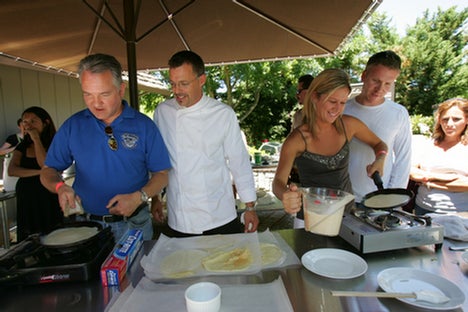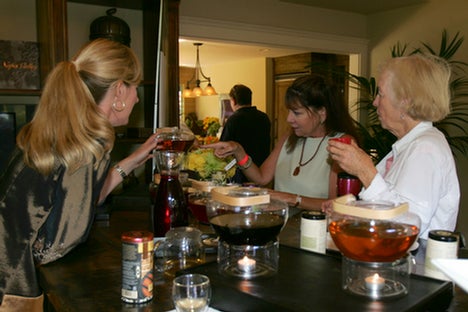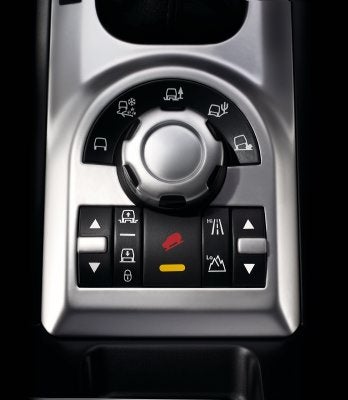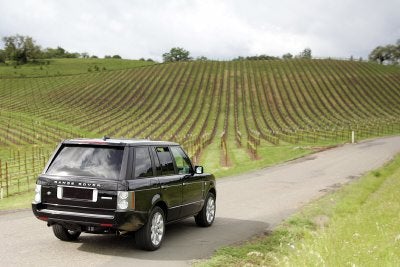ORC REVIEW
My editor didn't have to ask me twice about this one: Did I want to show up at a private event nestled in Wine Country and take a 2007 Range Rover test drive with a topnotch instructor from one of the best off-road driving schools in the country? Just let me grab my Louis Vuitton driving gloves and I'm there.
After changing ownership hands for many years, Land Rover now belongs to Ford Motor Company. It was somewhere around the late 90s during the growth of the SUV market, when vehicles such as the Land Rover line were elevated into the luxury segment to fit the high class demographic that it caters to today.
I drove a 4-door 2007 Range Rover HSE with a 6-speed automatic transmission, and a 305-horsepower 4.4-liter V8 engine, packing 325 ft-lb of torque. National average estimated market price (EMP) is around $90,586.
THE RANGE ROVER CHEESEBURGER EXPERIENCE
 |
Our day began at Greystone, a beautiful private residence with a $30,000 a month rental fee, nestled off Highway 12 in the heart of Sonoma County Wine Country and the Sugarloaf Mountain range. We received a warm welcome, in the form of herbal drinks from the Republic of Tea, accompanied by delectable cheesecake lollypops. This was going to be one hell of plush day . Also on the Range Rover Experience menu was a gourmet magazine featured chef, giving cooking lessons about crepes. We chowed down other delicious foods served in unreal portions and containers, like mini-cheeseburgers, and macaroni in espresso-sized cups. I was getting a tiny taste of the good life. As I knocked back my third parfait in a shot glass, I wondered what the other half of the world was doing. And would the vehicle impress me as much as this grandiose layout?
 |
There is a fine line between arrogance and confidence, and I like the fact the Range Rover is not afraid to call itself the world's most complete luxury sport utility vehicle. As it magically pulled up to me and I got in, I believed it.
A redesign of the Range Rover’s cabin was a major development for the 2007 model. The instrument panel, climate control system, airbag layout, trim fittings, switchgear, and storage facilities were all newly designed to reflect advancements in aesthetics, ergonomics, and technology. The front seats were redesigned to incorporate new whiplash-reducing head restraints. Front seat cool-air ventilation is now available as an option (standard on Supercharged) to supplement the standard seat-heating feature.
I felt at home behind the wheel. Okay, my home is not even this nice. At that impression, we were off.
AN ORCHESTRATED PERFORMANCE
 |
What I liked about my Land Rover instructor, Paul Cooper, is that he wasn't some PR-pleasing representative trying to sell me the vehicle. I was surprised when he chided me for not having both hands on the wheel as he interrupted my endless barrage of questions. As we weaved in and out of vineyards to our course destination, Paul never cracked me a smile once, and so I knew I had a seasoned vet that would show me the beast behind this great beauty.
As we hit our dusty, ascending hill, the first get-to-know-you icebreaker activity was becoming acquainted with Range Rover’s Terrain Response™ system.
This is the control dial positioned on the center console that can automatically optimize a host of powertrain and chassis systems to suit different driving conditions. You may select one of five available modes to handle situations ranging from normal dry-pavement driving to snow, mud, sand, and extreme rock crawling. A center e-differential is standard on both models, but a new infinitely variable locking ‘e’ (electronically controlled) rear-axle differential has been added as optional HSE equipment to further enhance Range Rover’s traction.
Getting back to that host of powertrain and chassis system: The Terrain Response can control throttle response, automatic transmission operation, electronic differentials, anti-lock brakes, the air suspension, traction control, and Hill Descent Control. Do we even need a driver here? “Put the vehicle in 4WD and turn the knob to Mud/Ruts,” commanded Paul.
The real course stuff and the Range Rover technology party began when we reached the top of our hill. Paul advised me to put her in Low Range (4-LO) and switch to Rock Crawl. It felt like one nose-diving descent as the Range Rover tottered forward.
Paul told me to take my feet (notice the plural here) off the brakes and get to trust the system. Rover (we're on a first-name basis now) was able to find the ideal gear ratio to work itself over the many dips and ruts. Low Range worked with all six forward gears, offering twelve forward that worked with the 32-value V8. I wished I had grabbed one more cup-‘o-macaroni-noodles for the road and that Paul would let me put my feet up. It was that easy and comfortable. With the Hill Decent Control engaged, the vehicle automatically restrained its downhill speed, and can also do so in reverse.
CLOSING COSTS
There is no reason to be glossy or cleverly craft my words: Who wouldn't want this car? My question is, do endless parfaits and cheeseburgers come with it?
Probably not, so pull yourself back down to earth and think about the payments, which would be equivalent to a small mortgage, and the gas mileage, which gets about 14-mpg city and 19-mpg highway driving.
I had enough gall to ask Paul Cooper about Land Rover's questionable reliability issues. Paul, who owns a Discovery, gave me a very short list of exactly what he's had to replace on his model. He waxed philosophies about how those with high profiles come with high expectations and have a hard time living down bad press. Maybe, like how everything Britney Spears does is criticized simply because she's so well known? Those are my words, not Paul's. |






 Your Privacy Choices
Your Privacy Choices